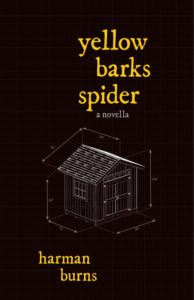Youth ‘in a feverish haze’
Yellow Barks Spider
by Harman Burns
Regina: Radiant Press, 2024
$22.00 / 9781998926190
Reviewed by Daniel Gawthrop
*

There’s a lot that’s original about Yellow Barks Spider. Let’s start with the likelihood that it’s the first debut Canadian fiction to be preceded by its author, three years earlier, with an album of ambient music bearing the same title—an album remastered and re-released a year before the book’s publication, the music inspired by a literary work-in-progress.
Harman Burns, who hails from Saskatchewan but now lives in Vancouver, is a trans video maker, sound artist, and writer who has released music under the names Plasticine Cowboy, Wands of the Minor Arcana, and Horse Daughter. “Yellow Barks Spider” was recorded during the summer 2021 heatwave. According to its Bandcamp summary, Burns produced it from “found objects, prepared guitar, and DIY electronics in a feverish haze.” The music ranges “from gentle electro-acoustic ambiences to roaring industrial noise, cut-up musique concrėte vocal manipulations to warped spaghetti-western psychedelia.”
The world within Yellow Barks Spider, the novella, also has chaotic elements and “feverish haze,” with filmic aspects aplenty. It would be stretching things to suggest that the prose and bits of verse constructing this story come off with the same effect as that of the musical version. (Yes, I gave it a listen: trippy and dreamlike in some parts, the opposite of “easy listening” in others.) But this 145-page literary work is filled with passages that demand to be read aloud, and I do not mean as “performance art.” That’s good news for a first-time author.
In some ways a mini-version of the classic Great Canadian Novel—a coming of age/coming home story largely set on the giant canvass of the prairies, with that obligatory sense of place—it’s also a haunting subversion of that same overdone CanLit subgenre, a blowing apart of the blood-is-thicker-than-water family saga. (You know: the kind that invariably ends with reconciliation, forgiveness, and redemption, or at least some kind of touching new wisdom on the protagonist’s part.) Yellow Barks Spider is one deep, intimate dive into trans consciousness, and Burns is an unsparing guide in taking us there.
When the story begins, the unnamed narrator—referred to only as “kid”—is a ten-year-old boy disturbed by the strange visions he encounters in his neighbour’s spider-infested shed. Tormented by shadowy memories, kid gradually retreats from his family and friends as he falls deeper and deeper into a haunted inner world. But first Burns takes us through her protagonist’s outer world, which is tactile and physical.
Like any curious young boy, kid—his fingers “sticky with plasticine”—is trying to form a figure (“a man, cowboy maybe”) while disturbed about dreams of the shed. He has awoken from those dreams “clawing at his pyjamas throwing off his covers trying to pull the spiders from his body.” When grandma cryptically informs him that dreaming of spiders means he’s growing up, kid ponders what this could mean:
kid thought about the things he promised himself he’d forget, the things he promised he’d bury forever in the deepest place a memory can go. he wondered if that’s what adults meant when they talked about growing up: learning to forget.
Adults are barely present in kid’s world, as disembodied as the robotic teacher’s voice in a Charlie Brown cartoon. We learn more about kid through his intimate relationship with nature. His is a world filled with spiders, mosquitoes, water beetles, grasshoppers, and other insects—a fascination his grandma rewards by giving him a bug-catching kit. Going out to the garden and into the bushes, he competes with “red-chested birds” for those insects while fending off leeches and ignoring the garter snakes.

A memory of collecting frogs in buckets—only to have them cruelly stolen by an older cousin who wants to burn them in the campfire—is an early warning that the world is a cruel place. The action moves quickly, from the violence of kid’s victimization at the hands of bullying boys to his supposed rescue by girls who lead him off and, with sensual charge while recognizing his vulnerability, take him somewhere to “let [him] in on a secret.”
After the sexualizing of his cuteness by these girls, there is a darkly comical moment when kid, freshly delivered from this trauma, is asked by his aunt for a photo of him because he “looks so cute” (triggering in this late Boomer reader an ear worm of the chorus from Elvis Costello’s “Watching the Detectives”).
With his grandpa going on about “what a man looks like” while watching Marlon Brando in a western on TV—prompting several poetic asides from kid about the meaning of “Marlon”—and the ever-menacing presence of local youth (there’s plenty of drinking and vomit, the constant spectre of juvenile delinquency, the threat of humiliation for not playing along), kid is always “trying to calculate the path of his escape.” He makes it to the city, starting over by working as a restaurant dishwasher and befriending a neighbour, a girl, who invites him to bed.
The passage to transition becomes increasingly surreal. There is shape-shifting as kid turns into a feral dog like one that attacked him, and gruesome imagery of contact with a calico cat. After an emergency that nearly burns down his apartment, Kid is doomed to leave the city and return home again. At about a hundred pages in, an intimate encounter with his forgiving neighbour becomes a critical moment of gender fusion, and kid’s pronoun changes.
Toward the end of Part Three, Burns interrupts the narrative with two pages of “Hormone Readiness Assessment Questions” for potential gender transition candidates. The questions—standard clinical inquiries about the subject’s gender history, informed consent issues, physical health, social supports, and mental health—come off as creepily intrusive, as they should: we share the narrator’s sense of unease in the face of questions that are deeply personal and not so straightforward to answer. (“Use whatever language makes sense to you,” the questionnaire not-so-helpfully advises.)
Compositionally, the novella is well anchored by Burns’s fast-moving prose, which tells the story alternatively in present and past tense. It begins with no capitalization for names, switching back and forth once before Part Two, when Burns applies conventional capitalization for names for the rest of the prose.
The occasional interruption of the prose with poetic verse or blocks of repeated text mirrors what’s going on in kid’s mind; as his/her imagination takes off, language itself destructs. (The first four pages of Part Five are consumed by “It is hard to break a pattern” interrupted by brief interrogations of that phrase.)
Burns is a good enough writer that such experimentation—some might say affectation—does not diminish the overall impact of this disturbing but often funny and highly engaging story.

*

Daniel Gawthrop is the author of a novel, Double Karma, and five nonfiction titles, including The Rice Queen Diaries. Visit his website here and his Substack here (https://danielgawthrop.substack.com/). [Editor’s note: Daniel Gawthrop has reviewed Ed Willes, Billy-Ray Belcourt, Yeji Y. Ham, Chad Soon and George Chiang, Hirsch and Cheryl A. MacDonald and Jonathon R.J. Edwards (editors), Valerie Jerome, Niloufar-Lily Soltani, and Brett Popplewell for BCR.]
*
The British Columbia Review
Interim Editors, 2023-25: Trevor Marc Hughes (non-fiction), Brett Josef Grubisic (fiction and poetry)
Publisher: Richard Mackie
Formerly The Ormsby Review, The British Columbia Review is an online book review and journal service for BC writers and readers. The Advisory Board now consists of Jean Barman, Wade Davis, Robin Fisher, Barry Gough, Hugh Johnston, Kathy Mezei, Patricia Roy, and Graeme Wynn. Provincial Government Patron (since September 2018): Creative BC. Honorary Patron: Yosef Wosk. Scholarly Patron: SFU Graduate Liberal Studies. The British Columbia Review was founded in 2016 by Richard Mackie and Alan Twigg.
“Only connect.” E.M. Forster
One comment on “Youth ‘in a feverish haze’”